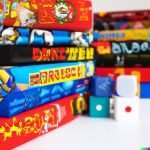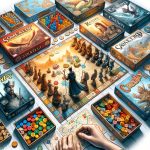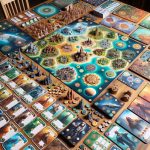In the world of gaming, DIY strategy board games are becoming increasingly popular among enthusiasts and casual players alike. These games offer a unique opportunity for creativity, critical thinking, and problem-solving skills to come together in a fun and engaging way. In this article, we will explore the world of DIY strategy board games, their history, benefits, and how you can create your own from scratch.
Strategy board games have been a significant part of the gaming world for centuries, with some of the most famous titles dating back to ancient civilizations. However, in recent years, there has been a resurgence of interest in creating and playing DIY strategy board games. This has led to an increase in community-based game design workshops, online tutorials, and a plethora of innovative game designs hitting the market.
Playing strategy board games provides numerous benefits for mental development and critical thinking skills. These games require players to think ahead, anticipate opponents’ moves, and adapt their strategies on the fly.
As a result, they offer an entertaining way to enhance cognitive abilities while also providing opportunities for social interaction with friends and family. Whether you’re a seasoned gamer or new to the world of strategy board games, creating your own DIY game offers an exciting challenge that can be tailored to your interests and preferences.
History of Strategy Board Games and Their Importance in the Gaming World
Strategy board games have been around for centuries, with evidence of early forms dating back to ancient civilizations. These games have continued to evolve over time, becoming a popular form of entertainment and mental stimulation for people of all ages. The history of strategy board games is rich and diverse, with each game offering its own unique set of challenges and excitement.
The importance of strategy board games in the gaming world cannot be overstated. These games require players to think critically, plan ahead, and make strategic decisions in order to outsmart their opponents. This not only provides an engaging and intellectually stimulating experience for players but also helps develop important skills such as problem-solving, decision-making, and patience.
Some popular strategy board games throughout history include Chess, Go, Risk, and Settlers of Catan. Each game has its own set of rules and objectives, offering a wide variety of options for players to choose from. With the rise of DIY strategy board games, more and more people are taking interest in creating their own unique versions of these classic games.
Benefits of Playing Strategy Board Games
- Enhanced critical thinking skills
- Improved decision-making abilities
- Boosted problem-solving capabilities
As the popularity of strategy board games continues to grow, it is important to recognize the historical significance and impact these games have had on the gaming community. Whether playing classic titles or creating DIY versions at home, strategy board games offer a timeless way to challenge oneself mentally while having fun with friends and family alike.
Benefits of Playing Strategy Board Games for Mental Development and Critical Thinking Skills
Playing strategy board games offers numerous benefits for mental development and critical thinking skills. These games require players to think ahead, plan their moves, and make decisions based on the information available to them. As a result, individuals who regularly engage in playing strategy board games develop better analytical and problem-solving abilities.
Enhanced Cognitive Skills
One of the primary benefits of playing strategy board games is the enhancement of cognitive skills. These games require players to strategize, anticipate their opponents’ actions, and adapt their tactics accordingly. This constant mental engagement helps in improving memory, concentration, and overall cognitive abilities.
Improved Decision-Making Abilities
Another significant benefit of playing strategy board games is the improvement in decision-making abilities. Players are often faced with multiple options and must carefully weigh the potential outcomes of each choice before making a move. This process encourages individuals to consider different possibilities, evaluate risks, and make informed decisions – skills that are highly valuable in various real-life scenarios.
Development of Critical Thinking Skills
Playing strategy board games also fosters the development of critical thinking skills. Participants must analyze game situations, assess their strengths and weaknesses, and devise effective strategies to achieve their objectives. This continuous exercise in critical thinking helps individuals become more adept at evaluating complex situations, identifying patterns, and finding innovative solutions – all of which are essential for success in academic, professional, and personal pursuits.
Overall, the benefits of playing strategy board games for mental development and critical thinking skills are undeniable. Individuals looking to hone their cognitive abilities while enjoying an intellectually stimulating pastime can greatly benefit from engaging in these types of games. Whether it’s chess, Settlers of Catan or self-made DIY strategy board games, the mental workout provided by these activities is both challenging and rewarding for players of all ages.
How to Create Your Own DIY Strategy Board Game From Scratch
Creating your own DIY strategy board game can be a fun and rewarding project for both gaming enthusiasts and creative individuals. Whether you are looking to personalize your gaming experience or simply enjoy the process of crafting, designing and playing your very own game, DIY strategy board games offer endless possibilities for customization and innovation. Here is a step-by-step guide on how to create your own DIY strategy board game from scratch:
1. Conceptualize Your Game: Begin by brainstorming ideas for your game, including the theme, objective, rules, and gameplay mechanics. Consider what makes a strategy board game engaging and challenging, and think about how you can incorporate these elements into your own design.
2. Create the Game Board: Decide on the size and shape of your game board, whether it’s a traditional square board or a unique design. You can use materials like poster board, foam core, or even repurpose an old table for a larger playing surface. Consider using stencils or freehand drawing to add artwork and visuals to the game board that reflect the theme of your game.
3. Design Game Pieces: Think about what type of game pieces are needed for your DIY strategy board game such as tokens, figurines or cards. You can craft your own pieces using materials like clay, wood or cardboard. Ensure that each piece is visually distinct and reflective of the overall theme of your game.
4. Develop Game Rules: Clearly define the rules and mechanics of your game to ensure balance and fairness in gameplay. Test play your game with friends or family members to identify any potential issues with the rules or gameplay flow.
By following these steps and putting thought into each aspect of your DIY strategy board game creation process,you can develop an engaging and enjoyable gameplay experience that reflects your creativity and vision for strategic gaming.
Materials and Tools Needed for Creating DIY Strategy Board Games
Creating your own DIY strategy board game can be a fun and rewarding experience. To get started, you will need a variety of materials and tools to bring your game to life. The first essential item you will need is a sturdy and large enough board or surface to create your game on. This could be a wooden board, foam board, or even cardboard if you’re on a budget.
In addition to the board, you will also need some basic art supplies such as markers, colored pencils, or paint to design the layout of your game. Depending on the complexity of your game, you may also want to invest in small game pieces, dice, or playing cards. These can typically be found at any hobby or craft store and are crucial for adding an interactive element to your game.
For creating the structure of your DIY strategy board game, you may need cutting tools such as scissors, an X-acto knife, or a paper trimmer. These tools will come in handy when cutting out any specific shapes or designs for your game pieces or board layout. Finally, don’t forget about adhesive materials like glue, tape, or Velcro to secure different elements of your game together.
With these materials and tools in hand, you’re well on your way to bringing your DIY strategy board game creation to life. Whether it’s a simple yet challenging puzzle-style game or a more complex and immersive strategic adventure, the possibilities are endless when it comes to creating your own unique board games at home using these essential items.
Step-by-Step Guide on Designing and Building a DIY Strategy Board Game
Gather Inspiration and Brainstorm Ideas
Before you start designing and building your DIY strategy board game, it’s important to gather inspiration from existing games and brainstorm ideas for your own unique creation. Take a look at different types of strategy board games, such as chess, Settlers of Catan, or Risk, to understand the mechanics and elements that make them engaging. Consider what theme or concept you want to incorporate into your game and how you can make it challenging yet fun for players.
Designing the Game Board and Pieces
Once you have a clear idea of the concept for your DIY strategy board game, it’s time to start designing the game board and pieces. You can use simple materials such as cardboard, paper, or foam board to create the game board itself. Think about how you want to divide the spaces on the board, whether you want to include special areas or obstacles, and how players will move their pieces around.
For the game pieces, consider using small figurines, tokens, or even custom-made pieces using clay or 3D printing. Each piece should have its own purpose and significance within the game mechanics. Design them in a way that reflects the theme of your game and adds visual appeal.
Testing and Refining Game Mechanics
After designing the game board and pieces, it’s essential to test out the mechanics of your DIY strategy board game to ensure that it’s balanced and compelling. Gather a group of friends or family members to playtest your game and gather feedback on what works well and what needs improvement. Use this feedback to refine the rules, balance out gameplay elements, and make any necessary adjustments before finalizing your DIY strategy board game for playtesting.
As you go through this step-by-step guide on designing and building a DIY strategy board game, remember that creativity is key. Don’t be afraid to experiment with new ideas and iterate on your design until you’ve created a unique and engaging experience for players of all ages.
Tips and Tricks for Making Your DIY Strategy Board Game Challenging and Engaging
Creating your very own DIY strategy board game can be an exciting and rewarding experience. One of the most important aspects of designing a successful game is making sure it is challenging and engaging for the players. Whether you are creating a game for children, adults, or mixed age groups, there are several tips and tricks that can help you achieve this goal.
One way to make your DIY strategy board game more challenging and engaging is to incorporate elements of uncertainty and surprise. This can be achieved through the use of random events or unpredictable outcomes that keep players on their toes. For example, you could include cards that have various effects when drawn, or create a system where certain spaces on the board trigger unexpected events.
Another tip for making your DIY strategy board game more engaging is to strike a balance between luck and skill. While some level of luck can add excitement to the game, it’s important to ensure that skill and strategic thinking also play a significant role in determining the outcome. This will make the game more dynamic and appealing to a wider range of players.
Additionally, consider incorporating multiple paths to victory in your DIY strategy board game. Allowing different strategies and tactics to lead to success can make the game more interesting and replayable. This gives players the opportunity to explore different approaches and keeps them engaged as they strive for victory.
Finally, don’t underestimate the power of theme and aesthetics in making your DIY strategy board game more captivating. A well-designed game with attractive visuals and a compelling theme can draw players in and enhance their overall gaming experience.
| Tips for Making Your DIY Strategy Board Game Challenging | Benefits |
|---|---|
| Incorporate elements of uncertainty and surprise | Adds excitement to the game |
| Strike a balance between luck and skill | Makes the game dynamic and appealing |
| Incorporate multiple paths to victory | Makes the game interesting & replayable |
DIY Strategy Board Games Ideas and Inspirations for Different Age Groups and Skill Levels
Creating your own DIY strategy board games can be a fun and rewarding experience for individuals of all ages and skill levels. Whether you are designing a game for kids, teens, or adults, there are endless possibilities for creating unique and engaging gameplay experiences. From simple games suitable for beginners to complex challenges that will test the skills of experienced players, here are some ideas and inspirations for DIY strategy board games tailored to different age groups.
For young children, consider designing a game that focuses on basic counting, color recognition, or simple decision-making skills. A game where players must collect items based on specific colors or shapes can be both educational and entertaining.
For older kids and teens, more complex games that involve strategic thinking, resource management, or tactical planning can provide an exciting challenge. Incorporating themes such as fantasy adventures, historical battles, or futuristic quests can also add an extra layer of immersion to the gameplay experience.
Adults who enjoy strategy board games often appreciate games that offer deep strategic choices, meaningful player interactions, and balanced gameplay mechanics. Creating a DIY strategy board game for adult players may involve developing intricate rulesets, varied player paths to victory, and dynamic decision-making elements. Themes such as political intrigue, economic simulations, or military conquests can appeal to adult gamers looking for immersive and thought-provoking experiences.
No matter the age group or skill level you are targeting with your DIY strategy board game, remember to prioritize clear rules and engaging gameplay mechanics to ensure a positive gaming experience.
| Age Group | Ideas and Inspirations |
|---|---|
| Youth (Under 10) | Simple counting games with colorful themes |
| Teens (11-17) | Complex challenges with strategic thinking aspects |
| Adults | Intricate rulesets with meaningful player interactions |
Conclusion
In conclusion, DIY strategy board games have become a popular and engaging activity for people of all ages. As we have seen, the history and importance of strategy board games in the gaming world cannot be overstated.
Not only are these games entertaining, but they also offer numerous benefits for mental development and critical thinking skills. The ability to create your own DIY strategy board game from scratch provides a unique and rewarding experience, allowing players to express their creativity and design skills.
As the interest in DIY strategy board games continues to grow, the future looks promising for this niche within the gaming community. With the accessibility of materials and tools needed for creating DIY strategy board games, more people are likely to embrace this creative hobby. The endless possibilities for designing and building unique board games provide an opportunity for players to tailor their gaming experience to their preferences and skill levels.
Frequently Asked Questions
How Can I Make My Own Board Game?
Making your own board game can be a fun and creative process. Start by coming up with a unique game concept, whether it’s a strategy game, trivia game, or something else. Design the game board, pieces, and cards, and test the game thoroughly to ensure it’s balanced and enjoyable.
How Do You Create a Game Strategy?
Creating a game strategy involves understanding the rules of the game, analyzing different possible moves and their potential outcomes, and developing a plan to achieve your objectives. It also requires anticipating your opponents’ actions and adjusting your strategy accordingly. Practice and experience are essential for honing your strategic skills.
What Board Games Are Easy to Make?
There are several board games that are relatively easy to make at home, such as tic-tac-toe, checkers, or even a simple trivia game. These games typically require minimal materials like paper, cardboard, markers, or small tokens as playing pieces. With some creativity and effort, it’s possible to create entertaining board games with simple mechanics.

I love playing all kinds of games – from classics like Monopoly to modern favourites like Ticket to Ride.
I created this blog as a way to share my love of board games with others, and provide information on the latest releases and news in the industry.





